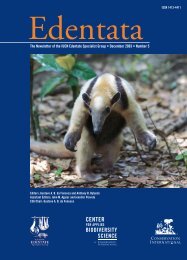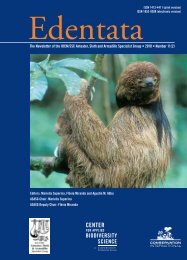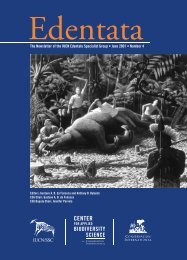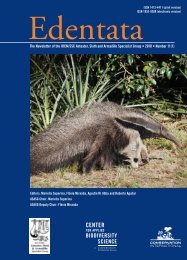Edentata 7 - Anteater, Sloth & Armadillo Specialist Group
Edentata 7 - Anteater, Sloth & Armadillo Specialist Group
Edentata 7 - Anteater, Sloth & Armadillo Specialist Group
- No tags were found...
Create successful ePaper yourself
Turn your PDF publications into a flip-book with our unique Google optimized e-Paper software.
ferences in transcription and pronunciation. Rather<br />
than list a dense tangle of infinite detail, we have<br />
tried to create a useful index of active common<br />
names, in hopes of providing an easy but thorough<br />
reference guide.<br />
For the Latin names we follow the working taxonomy<br />
of the Edentate <strong>Specialist</strong> <strong>Group</strong>, as presented in Fonseca<br />
and Aguiar (2004), which itself follows the taxonomy<br />
of Mammal Species of the World, Second and<br />
Third Editions (Wilson and Reeder, 1993, 2005).<br />
We have listed the species names in alphabetical order<br />
within each of the three major divisions of the Xenarthra;<br />
this is a linguistic rather than a phylogenetic<br />
display, and no particular taxonomic arrangement<br />
is implied.<br />
For the English common names, we rely primarily on<br />
Wilson and Cole’s Common Names of Mammals of the<br />
World (2000), which tracks the taxonomy presented<br />
in Wilson and Reeder (1993). We use these names<br />
as our default standard, and they are presented first<br />
in the tables below. These names are generally used<br />
by the other major sources, but in cases where they<br />
provide different terms we have cited them individually.<br />
Superina (2000) adds several sensible variants<br />
which we felt should be included, and Duff and Lawson’s<br />
recent book, Mammals of the World: A Checklist<br />
(2004) is a valuable secondary source.<br />
There appears to be no Spanish counterpart to Wilson<br />
and Cole (2000), so for the primary names in Spanish<br />
we have relied on Neotropical Rainforest Mammals<br />
by Emmons and Feer (1997), and the three volumes<br />
of Mammals of the Neotropics by Eisenberg and Redford<br />
(1989, 1992, 1999). Emmons and Feer in particular<br />
give a wealth of names in more than a dozen<br />
languages, although their focus excludes most of the<br />
armadillos. We have also referred to Gene Montgomery’s<br />
1985 volume on The Evolution and Ecology of<br />
<strong>Armadillo</strong>s, <strong>Sloth</strong>s, and Vermilinguas.<br />
We have drawn the Portuguese names from several<br />
sources, primarily Fonseca et al. (1996) and Emmons<br />
TABLE 1. <strong>Sloth</strong>s.<br />
Latin English Spanish Local names in Spanish Portuguese<br />
Bradypus pygmaeus pygmy sloth (Anderson<br />
and Handley, 2001);<br />
pygmy three-toed sloth<br />
(Duff and Lawson,<br />
2004)<br />
perezoso pigmeo perico (Pn) preguiça-pigmeu (Aguiar and<br />
Fonseca, in review)<br />
Bradypus torquatus<br />
Bradypus tridactylus<br />
Bradypus variegatus<br />
Choloepus didactylus<br />
Choloepus hoffmanni<br />
maned three-toed sloth;<br />
maned sloth (Eisenberg<br />
and Redford, 1999)<br />
perezoso de tres<br />
dedos<br />
pale-throated perezoso de tres<br />
three-toed sloth; dedos<br />
pale-throated sloth<br />
(Eisenberg and Redford,<br />
1999)<br />
brown-throated<br />
three-toed sloth;<br />
brown-throated sloth<br />
(Eisenberg and Redford,<br />
1999)<br />
Southern two-toed<br />
sloth; Linnaeus’s twotoed<br />
sloth (Wilson and<br />
Reeder, 2005)<br />
Hoffmann’s two-toed<br />
sloth<br />
perezoso de tres<br />
dedos<br />
perezoso de dos<br />
dedos<br />
perezoso de dos<br />
dedos<br />
n/a<br />
pereza de tres dedos guayanesa<br />
(Ve)<br />
aí-pixuna, preguiça-preta<br />
(Emmons and Feer, 1997);<br />
preguiça-de-coleira (Fonseca<br />
et al., 1994)<br />
aí, preguiça-de-bentinho<br />
(Emmons and Feer, 1997);<br />
preguiça-de-tres-dedos<br />
(Fonseca et al., 1996)<br />
perezoso bayo (Ar); perico (Bo); preguiça-de-bentinho (Emmons<br />
mono perezoso, perico ligero (CA, and Feer, 1997); preguiçamarmota<br />
(Redford, 1994);<br />
Mex); perica ligera (CR); perezoso<br />
de tres dedos de garganta café, preguiça-comum (Lara-Ruiz<br />
perezoso de tres uñas (Ec); perico and Srbek-Araujo, 2006)<br />
lerdo (Ho); pelejo (Pe); pereza de<br />
tres dedos común (Ve)<br />
perico ligero (Co); perezoso<br />
amazónico de dos uñas (Ec);<br />
cucala (Ho); pelejo (Pe)<br />
perico ligero (Co); perica ligera<br />
(CR); perezoso de dos uñas de<br />
occidente (Ec); cucala, perico<br />
lerdo (Ho); pelejo (Pe); pereza<br />
cara amarilla, pereza de dos<br />
dedos zuliana, pereza lanuda (Ve)<br />
preguiça real, unau (Emmons<br />
and Feer, 1997)<br />
preguiça real, unau (Emmons<br />
and Feer, 1997)<br />
Abbreviations: Ar=Argentina; Bo=Bolivia; CA=Central America; Co=Colombia; CR=Costa Rica; Ec=Ecuador; Ho=Honduras; Mex=Mexico; Pn=Panama; Pe=Peru;<br />
Ve=Venezuela.<br />
34<br />
<strong>Edentata</strong> no. 7 • May 2006














